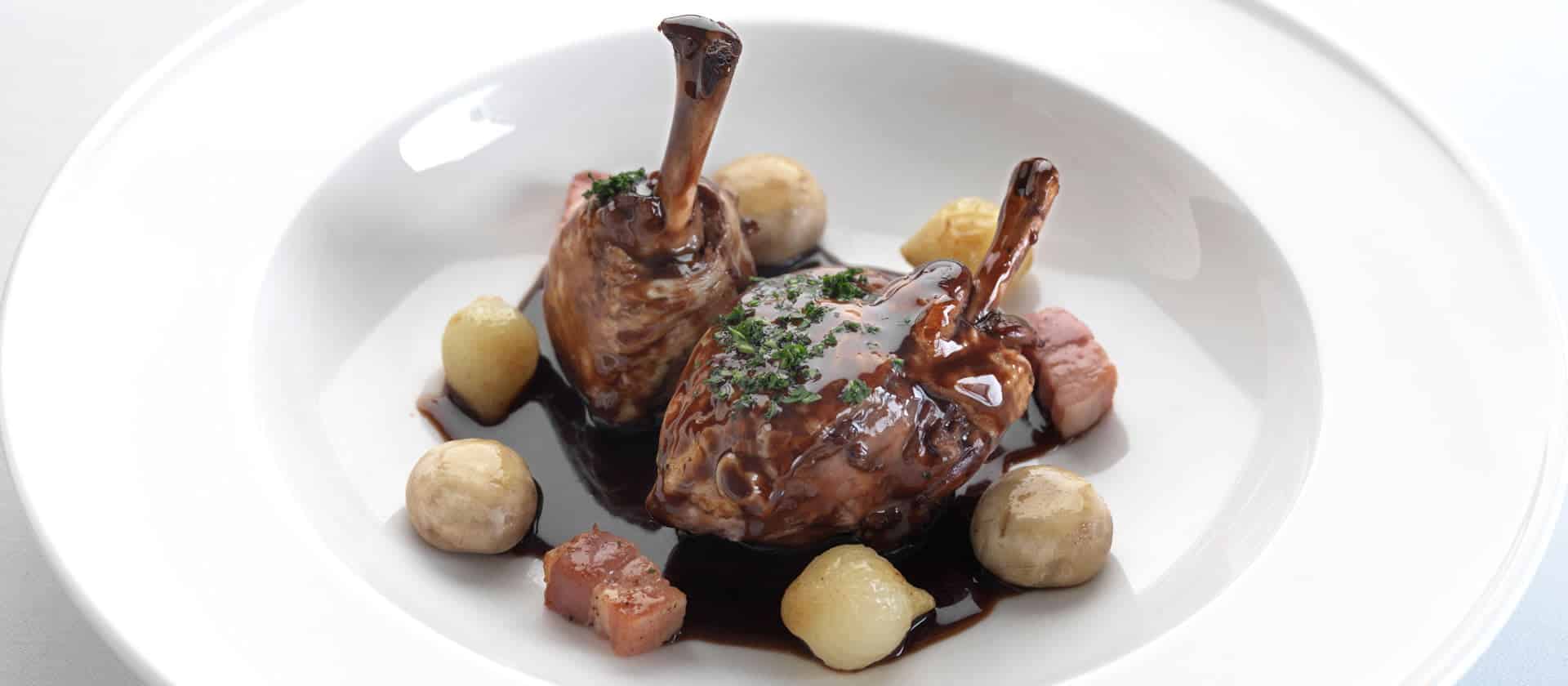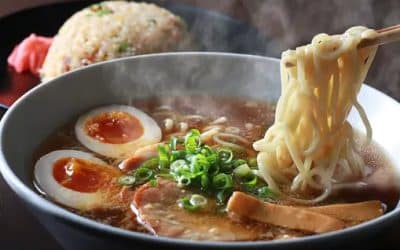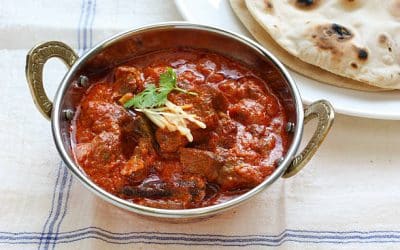Coq au Vin is a classic French dish that translates to “rooster with wine.” It’s a rustic and flavorful stew made with chicken, red wine, and a medley of vegetables. The fancy name might make it sound complicated, but it’s not. “Coq” means rooster, and “au vin” means in wine. So, basically, it’s chicken cooked in wine!Traditionally, this dish was prepared using older, tougher roosters that required long, slow cooking to become tender.
Origins
The Coq au Vin dish originates from the Burgandy region of France where chicken is braised with wine, lardons and mushrooms. People believe it began way back when warriors in France would cook their captured roosters in wine and herbs after a victory. It was a way to celebrate and enjoy a tasty meal. Over time, this warrior’s feast turned into a classic home-cooked dish that grandmas and chefs alike love to make.
The dish was traditionally made with a rooster (coq). Nowadays, chicken is more commonly used due to its availability and tenderness.
Preparation
You can cook everything in one pot, which means less washing up! Who doesn’t love that? The preparation of Coq au Vin does involve several key steps:
- Ingredients The main components of Coq au Vin include chicken pieces (usually on the bone for enhanced flavor), red wine, aromatic vegetables (such as onions, carrots, and celery), mushrooms, bacon or lardons, garlic, and fresh herbs like thyme and bay leaves.
- Marination The chicken is often marinated in red wine along with the vegetables, garlic, and herbs. This not only infuses the chicken with flavors but also helps tenderize the meat.
- Sautéing The marinated chicken is first seared in a Dutch oven or similar heavy-bottomed pot to develop a rich brown crust. This step adds depth and color to the final dish.
- Browning Lardons Bacon or lardons (small strips of bacon) are usually browned in the same pot. These add a savory, smoky flavor to the dish.
- Deglazing After the chicken and lardons are browned, the pot is deglazed with a bit of red wine, loosening any flavorful browned bits stuck to the bottom of the pot. This step contributes to the overall depth of flavor.
- Simmering The chicken, vegetables, and bacon are returned to the pot. Additional red wine is added along with enough chicken or beef broth to cover the ingredients. The mixture is then brought to a simmer.
- Slow Cooking The dish is slow-cooked over low heat for an extended period, allowing the flavors to meld and the chicken to become tender. This can take a few hours.
- Mushrooms and Garnishes Mushrooms are often sautéed separately and added to the pot toward the end of cooking. The final dish is garnished with fresh herbs like chopped parsley.
Cookware recommended to prepare Coq au Vin
Cocotte or Dutch Oven The heart and soul of Coq au Vin preparation is the cocotte, or a heavy-duty Dutch oven. This robust, cast-iron pot conducts heat evenly, ensuring your chicken simmers to perfection. Its deep sides allow for slow cooking and melding of flavors as the ingredients simmer together.
Chef’s Knife Before you start cooking, you’ll need a trusty chef’s knife for chopping onions, carrots, and garlic—the aromatic foundation of this classic dish.
Cutting Board A sturdy cutting board provides a reliable surface for all your chopping and prep work, keeping your kitchen tidy and efficient.
Skillet To sear the chicken to golden-brown perfection before transferring it to the cocotte, a skillet is essential. The French love their cast-iron skillets for this task.
Wooden Spoon You’ll stir and sauté your Coq au Vin ingredients with a wooden spoon, a simple yet invaluable tool that won’t scratch your cookware.
Tongs Tongs help you handle the searing chicken pieces with precision and ease, ensuring they acquire that irresistible color and flavor.
Wine Opener Coq au Vin wouldn’t be the same without a generous pour of red wine. A trusty wine opener is your gateway to a bold and flavorful sauce.
Ladle This utensil is your ticket to serving up ladlefuls of rich, wine-infused sauce over tender chicken and mushrooms. It’s an essential part of the Coq au Vin experience.
Oven Mitts As your cocotte goes from stovetop searing to oven simmering, oven mitts or pot holders are your best friends for handling the hot cookware safely.
Platter or Serving Dish When your Coq au Vin is ready, a beautiful platter or serving dish lets you present this French masterpiece with style.
Variations
While the basic preparation remains consistent, there are regional and personal variations of Coq au Vin. Some variations include:
- White Wine Coq au Vin Instead of red wine, this version uses white wine, resulting in a lighter, less robust flavor profile.
- Mushroom Variations Some versions incorporate different types of mushrooms for added texture and flavor complexity.
- Modern Adaptations Coq au Vin has inspired modern twists, including using boneless chicken for quicker cooking or incorporating creative ingredients like shallots, pearl onions, and even different herbs and spices.
- Instant Pot or Slow Cooker Coq au Vin With the rise of kitchen appliances like the Instant Pot and slow cooker, there are adaptations that allow for more convenient cooking while still capturing the essence of the dish.
Calories and nutritional values
Coq au Vin’s nutritional values can vary based on the specific ingredients used, their quantities, and the cooking method. I provided a general overview based on a typical recipe. Remember, these are approximate values and actual numbers can differ based on the specifics of the preparation.
Typical Coq au Vin (per serving):
- Calories – Approximately 350-450 calories
- Protein – 25-30 grams
- Total Fat – 15-25 grams
- Saturated Fat – 4-6 grams
- Unsaturated Fat – 8-15 grams
- Carbohydrates – 10-20 grams
- Dietary Fiber -1-3 grams
- Sugars – 2-5 grams
- Cholesterol – 70-100 mg (mainly from chicken and bacon)
- Sodium – 400-800 mg
- Potassium – 400-600 mg
- Vitamins and Minerals
- Vitamin A – 30-50% of the Daily Value (DV) mainly from carrots
- Vitamin C – 10-20% of DV mainly from veggies
- Calcium – 2-4% of DV
- Iron – 8-15% of DV
A few factors to consider
- Type of Chicken – Using skinless chicken can reduce the fat content.
- Wine – The alcohol in the wine mostly cooks off, leaving behind its flavors without much of its caloric content.
- Bacon/Lardons – These can significantly impact the dish’s fat and sodium content.
- Serving Size – Portions can significantly affect calorie and nutrient intake.
It’s important to note that while Coq au Vin has a moderate calorie count, it’s rich in protein and provides essential vitamins and minerals from the vegetables and herbs. However, if you’re particularly health-conscious or are adhering to a specific diet, it’s advisable to refer to specific recipes or use nutritional calculators for precise values.
Conclusion
Coq au Vin is a true classic dish that embodies French comfort food, bringing together robust flavors, slow cooking, and a celebration of the culinary heritage of France. Coq au Vin is more than a dish; it’s a culinary ballet of flavors, and a celebration of French gastronomy. With the right cookware in hand, you’ll be transported to the cozy bistros of France, where the art of cooking is cherished, and every bite is a taste of tradition and sophistication. Bon appétit!









0 Comments